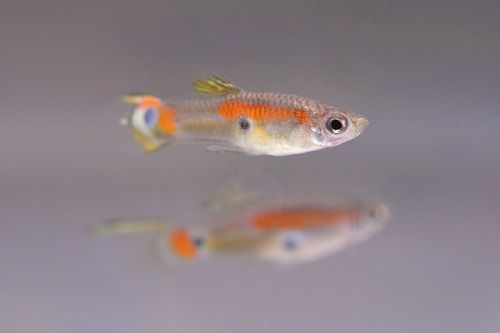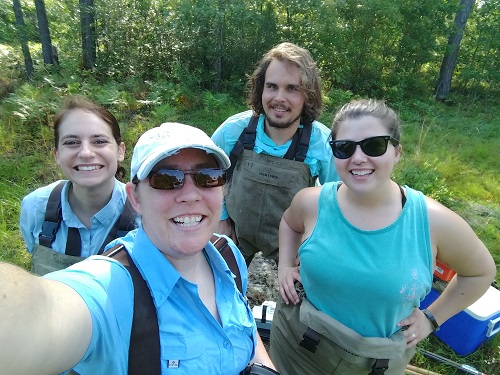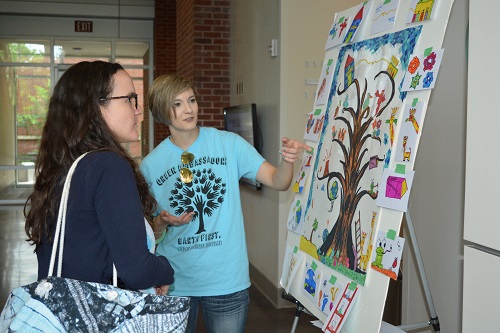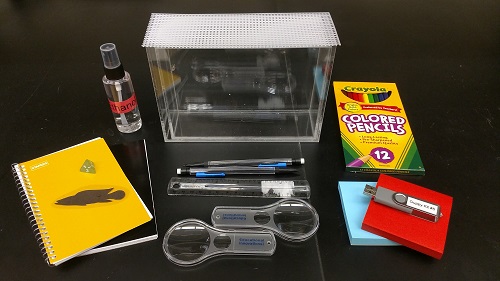About the department: GSU is a public, 4-year, doctoral research university and is the largest public institution in southeast Georgia with almost 30,000 students. GSU is predominantly an undergraduate institution that values innovative teaching and productive research programs. In Biology, we work closely with undergraduate and Master’s students to integrate research and teaching and provide students with unique opportunities to develop their interests.
About the research: I refer to my lab’s work as “Ecological and Evolutionary Biomechanics”. Our questions center around how animals survive and adapt to their environment, especially when they have to integrate multiple functional systems to do so. For example, how does specialization for swimming behavior affect the ability to integrate swimming with feeding during prey capture in fishes? We have worked mostly with Trinidadian guppies, but are also starting projects with local sunfishes.
On being a new faculty member: What has been the biggest challenge as a new PI? The biggest challenge has been ensuring that I continue to make progress in all areas while assuming new roles and responsibilities that I didn’t necessarily train for. There is a significant learning curve when starting any new position, but as a new assistant professor there have been so many new things all at once, and so many new things for which I am now the one responsible. I started in January of my first year, which in some ways made me feel I was behind. I had to start recruiting graduate students before I even had the lab set up and had to spend my first year’s startup by the end of that May. For anyone interested in what it was like, I wrote a
blog post about my first semester. This helped me realize exactly how much I had accomplished in one semester, even though I still felt behind on several things. I have had tremendous support from my department, colleagues, and family, who were invaluable in getting through these challenges. Some parts have been getting easier since then, but there are always new challenges as you become more experienced with the old ones. For example, I was hired to develop a new course on Biomechanics which I will teach for the first time this fall semester.
What advice would you give to a new PI? No matter how much you think you have prepared to lead your own lab, the first few years will be challenging. It is important to find people in the department who can provide resources, offer solutions to things you’re struggling with, remind you why they chose you and why you’re valuable to them, and support you when you need an extra hand. Also, consider how much work it will be to start new research projects; even if you are experienced with the study system, animal care, equipment, etc., chances are you will require new permits and approvals, there might be constraints on space or other resources, you will have to train personnel, you may have newer versions of the equipment that require you to learn it again (including operating systems), or you may be purchasing equipment you know how to use *in theory* but have never done the process yourself and you realize part-way through that you didn’t purchase critical items.
My approach has been to start a big, expensive project early, while I have money, since funding can be challenging for basic science questions. However, this means that at any given time there have been around 10 undergraduates in the lab and now 2 graduate students. Since we don’t have PhD students and it’s rare to have postdocs or lab technicians, that means I am heavily involved in ensuring that everyone’s time is being used in a way that helps them achieve their goals as well as mine. I was actually recommended not to start with a big lab, but a series of situations and quick decisions meant this was the way we would go. I cannot thank my students enough for how team-oriented, dedicated, and patient they have been, and the lab would not be where it is now without their hard work! We’re starting to see some interesting results from this project and I can’t wait to bring them to the Evolution conference next summer!
Are you recruiting? What do you look for in students?
Yes, I am always looking for motivated students to join my lab! I am looking for students who are interested in how parts of an animal work together and what that means for survival and evolution. I understand that potential students won’t have everything figured out and that’s why they need my help. Therefore, I don’t expect that students will know exactly what they want to study when they contact me, but I do expect that they can tell me why they are interested in this idea and working with me. I like to give Master’s students a “starter” project to get them going their first year. If there wasn’t something specific I recruited the student to work on and it’s in the student’s best interest, I may also allow them to develop their own ideas for a second project. In addition to research, I am also looking for students who have an interest in science education and outreach and can help grow the lab’s impact in this area. Not only do I think it’s important to develop significant research questions, but it’s equally important to be able to convey those ideas to broader audiences. This is an increasingly important skill for students to have experience with given the diversity of job opportunities available to them after their degree.
On SSE membership: When and why did you become a SSE member? As a graduate student, I considered myself more of a biomechanist and the Society for Integrative and Comparative Biology meetings were my go-to meetings, especially since it was difficult to afford more than one per year. However, when I began to think about my interests beyond my PhD, I knew I wanted to learn more about evolutionary biology because I saw a need for understanding how mechanical traits evolve and how they may impose constraints on other traits. I targeted Cameron’s lab as one where I could integrate these ideas while also building on my understanding of evolutionary processes and mechanisms. I joined SSE and attended my first meeting in 2016 in Austin, TX. This had been my goal for some time, and I finally had a project and some new data I thought would fit. I also wanted to present our outreach work to get feedback and help share our work for others to use. I had a blast at that meeting! I was able to catch up with friends that I don’t see at other conferences, see talks and hear about ideas I wouldn’t see at other conferences, and meet people that work outside of my main study area, including guppy researchers that work on different questions. Since then, I have been impressed with the society’s commitment to diversity and early career researchers, and I look forward to continued involvement in the future. I intend to continue attending Evolution meetings as often as I can!
Have any members of SSE inspired you in your career? Neither of them probably remember this, but I met both Hopi Hoekstra and Judith Bronstein early in my time as a PhD student. They were both invited for a seminar by the graduate students while I was at Clemson University (Hopi) and UC Riverside (Judith). I went to a graduate student lunch with Hopi and I remember how amazed I was with her research and how inspired I was to see a female evolutionary biologist who had such an impact on her field. I remember thinking it might be possible for me too. It was also refreshing talking to someone so “famous” who really just wanted to chat with some graduate students about science. When Judith came to UC Riverside I volunteered to take her to the airport at the end of her visit. I was intimidated at first because again she was so “famous” and this was an hour drive, but it quickly became apparent that my concern was unfounded. She asked me about my work and gave me advice on things I was struggling with. I asked her some questions about publishing and she told me that she loves working with students because she likes to find the hidden gems. This stood out because reviewing seemed to be so critical that it’s often perceived as negative. I was so inspired by this conversation and I became convicted to take this same approach in lab meetings, grading student papers, and manuscript reviews. Of course, there are other role models I’ve met over the years as well, but Hopi and Judith stand out because they left such a positive impact so early in my career.
On life outside the lab: Do you teach evolution? What concept blows students’ minds?
I taught upper level Evolution for the first time this past spring. All Biology students take a sophomore level class to cover the basics of Evolution as well as the diversity of life, so most of them came in with a fair amount of knowledge. But I remember in one class I casually mentioned as an example how we are all fish, technically. I kept explaining the original concept and a few minutes later a student raised her hand and said “Wait, go back. I’m a fish?!” I thought that given the previous class this may have been a familiar concept but it made me realize how these kinds of connections may not be obvious to students, even when they understand phylogenetic trees and the evolutionary process. I also realized I glossed over one of the coolest evolutionary stories! So we spent some extra time discussing Neil Shubin’s
Your Inner Fish and I realize now that I shouldn’t expect that students know what I’m talking about.
Are you involved in evolution outreach? Tell us about it. As part of my postdoc at Colorado State University I became involved in a collaborative project to use authentic science with live guppies to supplement evolution education in local middle schools. A (then) graduate student, Dale Broder, worked with my advisor as well as local teachers to develop a program that would connect scientists with local schools to help students learn about evolution by discovering it for themselves. My role was to help turn this program into something more sustainable, since researchers can’t always be present in classrooms. I developed collaborations with the CSU Education and Outreach Center, who use kit designs to supplement STEM education. They helped us turn the 5-day program into a 1.5-hour kit. It took Dale several years to develop the original program, perform assessments, and publish her work. It took us a year to design and build the kits and about another year to test the kits and get feedback from teachers and colleagues. It took us one more year to get the guppy kit program published in
American Biology Teacher. The goal of this publication was to provide all the materials and information necessary for educators to adapt the program to their own classrooms.
During my time at Georgia Southern, I have been working with Amanda Glaze (Department of Teaching and Learning) and Kania Greer (Institute for Interdisciplinary STEM Education) to build and use a set of kits here in South Georgia. To read more about these kits, see my
website and my
blog post about our publication. This is my most well-developed effort, but I am always looking for ways to engage the community in thinking about evolution. For example, my evolution students completed science communication projects and explained their topics to the public (including non-majors students) in the biology building foyer last spring.
Tips and Advice Do you have a time management tip to share? When I’m really struggling with time management, like in the middle of the semester, I use a list-making technique that helps me plan my time and ensure I can make steady progress. I start by making a list of all the things I want to accomplish by the end of the semester - reasonable things, not “publish 6 papers” but rather “submit conference abstract”. I then assign each task to a month I want to (or need to) accomplish them. Then I break them down further and plan tasks for each week to help me meet that goal - for example “finish analyzing data”, “backup videos”, “write abstract draft”, and “abstract revisions”. You could probably guess, then, that the next step is assigning those tasks, or parts of them, to days of the week - for example “double check data accuracy”, “run basic stats on data”, “run specific stats on data”, “make figures”. This list system may sound excessive, but I find that it helps me prioritize certain things each day and helps me plan ahead to complete tasks even when I have teaching, meetings, or other commitments interspersed. When I finish a thing, I can save time and move on to the next one rather than wonder what I should work on next, stress about not having enough time to do all the things, choose something easy that isn’t necessary yet, and waste time tackling my list inefficiently.
What is something most people don’t know about you?
I did a Semester at Sea in college where we sailed a 125’ schooner from St. Thomas, down to Tobago, back up through the Dominican Republic and up the eastern US to New York. Our families met us in Greenport, Long Island on the final day, so we spent the day before cleaning the ship. I was helping a deckhand in a small inflatable scrubbing the hull. It was choppy so some of the crew onboard threw a line over the side for us to hold onto. However, when the deckhand lost her balance and grabbed it, we discovered it was loose and she started to fall in. I tried to catch her and somehow she stayed in the boat and I did not. I was the only student to fall overboard on that trip and I did it on the last day. It was so cold that I was wearing several layers and all of them were soaked, leaving me few options to stay warm the following day as we came into port. Luckily, I didn’t have to wait long to re-acquire warm, dry clothes.
 Dr. Emily Kane
Dr. Emily Kane


